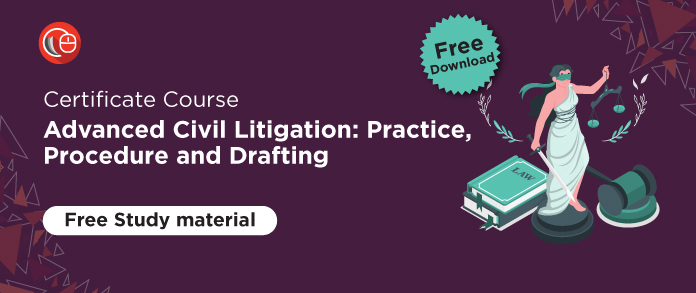This article is written by Pragya Agrahari of Amity Law School, Lucknow. This article provides a detailed analysis of professional negligence, its essential elements, examples, defenses, and important case laws.
It has been published by Rachit Garg.
Introduction
Why does a person generally prefer to approach any professional person like surgeons, physicians, lawyers, architects, accountants, or persons related to other professions for any task to be performed? What assurance do these professionals provide to their clients? To answer these questions, first, we have to deal with the definition of ‘professional.’ Though there is no specific definition of ‘professional,’ every professional shares some common characteristics, which are as follows:
- A professional is one who possesses a special skill to perform some specific task and requires a certain level of learning,
- They have duties and standards which must be obliged,
- They must profess reasonable care while performing the task.
People prefer professionals as they have the requisite skill to perform a task which assures them that they will exercise their skill with a reasonable degree of care and caution while performing the task. Thus, there are fewer chances of negligence at the hands of the professionals and in the case where negligence occurs, the client can claim compensation for the wrong of professional negligence under Torts.
What is professional negligence?
Professional negligence refers to negligence committed when a professional fails to adhere to reasonable care toward their client. Every professional has to follow a certain standard of duty that is generally accepted among them. Professional negligence occurs when there is a breach of this duty. In America, this is also known as malpractice. Professional negligence claims are most common against professionals like doctors and lawyers.
America does not have any national uniform law for the regulation of professions. Each of the 50 states and territories has different regulations and standards on this. Professional tort law is an amalgam of state regulations and common law principles and precedents.
Essential components of professional negligence
In the case of Budd v. Nixen (1971), the Court enumerated the important elements which must be present for a cause of action under professional negligence in tort, which are as follows:
- The duty of the professional to exercise reasonable skill, prudence, and diligence as other members commonly exercise,
- A breach of this duty by the professional,
- Damage or actual loss to any person resulting from professional’s negligence,
- A proximate causal connection between the person’s injury and the professional’s negligence.
These elements must be proved before the court in order to hold the professional liable for professional negligence.
Duty of care
The first element of professional negligence is that there exists a legal duty of the professional towards the client; this duty comes into play whenever a professional relationship is established between a professional and their client. The principle behind this is that each professional, whether it is a doctor, engineer, lawyer, or architect, owes some duty of reasonable care toward their client. This duty of the professional is assumed in the professional-client relationship. But when a professional serves their client outside the professional setting, the assumption of duty of reasonable care does not apply. For example, a doctor who is prescribing medicines outside his professional setting (like a clinic, hospital, etc), or a lawyer giving advice outside his chamber, or place of practice.
The professional has to observe a standard of care towards their client, which means that the professional should act reasonably and provide quality services to their clients. This standard of care varies across different professions and their place of practice. Some have defined their ‘code of conduct’ and standards, while some set the standards based on the typical behavior of the professional. If the professional fails to adhere to these standards, the client gets the right to sue the professional.
Judges generally use two methods to evaluate the ‘duty of care’ of the professional towards their client:
Foreseeability test
A foreseeability test is usually used to determine the cause of the accident that occurred. It basically asks whether the professional who caused such injury could have reasonably foreseen the probable consequences of their conduct. For example, if the doctor has reason to foresee that the patient will die if given a certain dosage of medicine and the doctor negligently gives that dosage, the doctor will be held liable for professional negligence.
Multifactor test
The multifactor test determines the ‘duty of care’ of the professional by looking into a number of factors, which may include:
- Nature and extent of damages caused,
- Was there any chance of taking an alternative action?
- Cost of taking such alternative action by the professional,
- Whether such alternative actions would have been safe?
Breach of duty
The plaintiff must prove that there is a breach of duty on the part of the professional. It means that the plaintiff has to demonstrate that the professional has done some careless action or has not taken certain actions required at that time. It means the professional breached his duty of care by allowing certain dangerous conditions beyond the normal level of risk. This is an important element in determining the negligence of the professional. For example, a chemistry teacher has a duty to warn students about harmful chemicals. If he has not done it, he has breached his duty and, therefore, will be liable under professional negligence.
Damage or actual loss
If the negligent conduct of the professional does not cause damage, no cause of action in tort will arise. “Damage” must mean actual damage, not nominal damages, and it will include both physical and emotional damage. It may be pain or suffering, monetary damages, loss in profit, etc.
In the case of Walker v. Pacific Indemnity Co. (1960), where the defendant, Fulmore, Merill’s insurance broker, “negligently and carelessly” procured a policy with limits of $15000 rather than $50000. Merill’s truck collided with an automobile, causing injury to Mrs. Walker, who sought damages for more than $100000 for injuries caused. Merill assigned this damage against his broker, who caused negligence. The question here was whether there were sufficient damages caused to Merill due to the broker’s negligence. The Court was of the opinion that there was no injury to Merill as a result of the defendant’s negligence until the point that the accident occurred.
Proximate causal connection
Apart from the above elements, it is equally important to prove that the injury or damage caused to the plaintiff is a result of professional negligence. It means that if the professional has not acted negligently, no cause of action will arise. For example, in case the patient dies as a result of the doctor’s negligence, one has to show that the doctor has prescribed the wrong medicines due to which the patient has died.
Categories of professional negligence
Negligence by medical practitioners
Each state in the American federation regulates the activities of medical professionals, including dentists, surgeons, physicians, nurses, etc. Negligence by medical practitioners forms a very large chunk of professional negligence cases. It is commonly known as medical malpractice.
The standard of care followed by medical practitioners is largely regulated by hospitals and professional and academic institutions. These standards vary from case to case basis.
Premises liability of medical professionals
The courts, in many cases, have addressed the issue of whether professional negligence includes the duty to use or maintain medical equipment and hospital premises. In determining this issue, the Court gave two conflicting decisions. In the case of Gopaul v. Herrick Memorial Hospital (1974), a pneumonia patient fell off the hospital gurney when left unstrapped and unsupervised. The Court opined that professional negligence was not committed as the need to strap the patient to the gurney did not require professional skill or prudence. Whereas, in another case of Murillo v. Good Samaritan Hospital (1979), where again the patient fell off the bed at night because the rails of the bed were not raised, the Court determined it a case of professional negligence and disagreed with the proposition laid down in Gopaul case. The Court stated that professional negligence was not about whether the case requires low/high skill but whether the negligent act occurred while rendering services for which the healthcare professional was licensed.
Case of negligent treatment and failure to inform
In the case of Burroughs v. Magee (2002), the defendant Dr. Magee treated Roger Hostetler prior to the automobile accident in which Hostetler hit the plaintiff’s car, which ultimately resulted in the plaintiff’s husband’s death. Prior to the accident, Hostetler, who was also a drug addict, had gone to Magee’s clinic complaining of headaches, persistent weakness, and muscle cramps. Dr. Magee prescribed him medicines that could impair his ability to drive. Moreover, if the two medicines were used simultaneously, the impairment may be enhanced. Dr. Magee failed to warn the patient about these potential risks. The question that arose here was whether Dr. Magee owed a duty to a third party when prescribing drugs to his patient. The court held that although Dr. Magee failed to warn the patients about the risks involved in taking medicines, he owed no duty to the plaintiffs, Burroughs, and her husband.
Negligence by lawyers
Each state maintains the right to license and regulate the conduct, ethics, and discipline of all the lawyers practicing in the country. Although each state has different systems to regulate legal professionals, nearly all jurisdictions follow the standards set by the American Bar Association Model Rules of Professional Conduct. When these rules are violated, the liability under professional negligence arises. It is also known as legal or attorney malpractice.
Lawyers who are experts in their field are expected to exercise their skill and prudence diligently as professed by other members of the same field. Generally, the breach of standard of care is determined by expert testimony in case of failure to exercise such care until the professional negligence is so apparent from the facts of the case that the expert testimony does not require it.
In the case of Wright v. Williams (1975), the respondent, an expert in maritime laws, was consulted by appellants for acquiring the title of the vessel Kona Sea to use it for carrying out a commercial diving venture. At that time, the amended section of the Merchant Marine Act of 1920 prohibited the use of a vessel for coastwide trade if it had been owned by an alien earlier. It also meant that the section prohibited the use of Kona Sea for the intended purpose as it was once owned by a Mexican national. Respondent, unaware of the intended purpose, arranged the transfer of the title of the vessel. Subsequently, the appellants were charged with the violation of the Marine Act. The appellants sued the respondent for attorney malpractice. The appellants’ contention failed due to lack of evidence or absence of expert testimony to claim that the respondent failed to exercise his duty of due care.
Negligence by architects
Design and real construction professionals such as architects and engineers are also regulated by state laws. They can get a license only after obtaining certain qualifications, such as passing an examination, certifications, or education courses. A specific standard of care to be exercised by the design professionals was laid out in the contract and in addition to it, states’ standards were followed. Claims, generally, are related to property damage and personal injury to the client or non-client as a result of negligence. For example, if, due to the negligence of the engineer, structural damages are caused to the neighboring property, the engineer may be liable for professional negligence.
Defenses against claims of professional negligence
In order to successfully negate one of the elements of professional negligence to defend against an action initiated under this head, the defendant can use the following defenses to limit or completely eliminate their liability:
Contributory negligence
It is one of the most commonly used doctrines to defend against negligence liability. Contributory negligence occurs when the plaintiff’s own negligence summed up with the defendant’s negligence, causes damages to the plaintiff. For example, in a case where the doctor negligently prescribed the wrong medicines to the patient, which were not harmful unless taken in high dosages, and the patient falls sick after consuming extra dosages of medicine, that was not normally taken. Here, both parties are at fault; the doctor has prescribed the wrong medicines, whereas the patient of his own volition, took the extra dosages without medical advice. Hence, it is a case of contributory negligence.
In the case of Gravitt v. Ward (1999), the plaintiff, Gravitt, filed a medical malpractice action against Dr. Ward, seeking damages for his negligence as he failed to order a mammogram and diagnose her breast cancer in a timely manner. In fact, the doctor gave a positive diagnosis of non-cancerous ‘fibrocystic changes.’ In response, Dr. Ward filed a defense of contributory negligence alleging that the plaintiff failed to tell him about the lump in her breast and that is why he was unable to diagnose the disease timely. At trial, both parties presented expert testimony supporting their contentions. The trial court allowed the defense of contributory negligence. Plaintiff challenged the decision. Plaintiff insisted that whether she told the doctor about the lump was an issue of primary negligence and not contributory negligence. Moreover, there was no more than a scintilla of evidence that shows Gravitt failed to inform the doctor about the lump, and that too was less serious in comparison to the doctor’s negligence. Therefore, the Supreme Court of Virginia held the decision of the trial court was an error and held that there was not sufficient evidence to hold Gravitt liable for contributory negligence.
Comparative fault
It is used as an alternative to the defense of contributory negligence and is also known as non-absolute contributory negligence. It seeks to compare the negligence of both the plaintiff and the defendant. If the plaintiff is at fault or at more percentage of negligence, the plaintiff is either barred from claiming the damages from the defendant or his recovery is reduced by the percentage of his fault.
In the case of Blackman v. Rifkin (1988), where the patient was admitted to the hospital in highly intoxicated state for treatment of scalp laceration. The patient was unable to communicate her medical history properly to the medical staff. Also, the patient was showing combative and obstructive behavior, which interfered with treatment and during the treatment, she regurgitated and aspired stomach contents into her lungs which resulted in permanent brain damage. She contended medical malpractice against E.R. Team, the defendants, due to the breach of standards that needed to be followed while treating intoxicated persons. The court allowed comparative negligence defense against the plaintiff.
Assumption of risk
When the plaintiff is aware of the possible risk involved in any activity but still agrees to proceed with that activity, the plaintiff cannot be able to recover damages from the defendant. For example, if the surgeon beforehand has informed the plaintiff about the possible risks involved in the surgery, and the plaintiff anyways agrees to it, he cannot later claim damages from the surgeon.
In the case of Gross v. Robinson (1920), where the plaintiff took too many X-rays even after the doctor’s warning, the court held that though the plaintiff was warned of the dangers of too many exposures to X-rays by the physician and thus assumed the risk, he did not assume the risk of too many exposures of machine which was not properly working. It means the plaintiff was fully aware of the risk involved in taking too many X-rays. So, if the patient willingly engages in the such act even after the physician’s warning, the physician will not be held liable. But in this case, the X-ray machine was faulty for which the patient had not assumed the risk.
Professional negligence vs ordinary negligence
Ordinary negligence refers to failure to exercise a reasonable amount of care and prudence while performing a certain activity. In order to prove it, one has to show that the defendant’s actions were reckless or careless. It does not involve any special type of relationship between the parties like doctor-patient, lawyer-client, etc. There are many examples of negligence like car accidents, dog attacks, product liability, etc.
On the other hand, professional negligence explicitly involves a professional with set standards of duty and his/her client. In this case, the professional is expected to maintain higher standards of duty of care according to his professional code of ethics or customs, unlike in ordinary negligence, where the person is expected to maintain a general duty of care. It is because the professional has more skill and special knowledge about their field than any other ordinary person. For example, if the drugs prescribed by the doctor cause an allergic reaction in the plaintiff, the doctor may be held liable for professional negligence.
Conclusion
In the case of Flowers v. Torrance Memorial Hospital Medical Center (1994), the Court stated, “With respect to professionals, their specialized education and training do not serve to impose an increased duty of care but rather are considered additional ‘circumstances’ relevant to an overall assessment of what constitutes ‘ordinary prudence’ in a particular situation.” It means the professionals are assumed to have higher skills and knowledge in their field than other members of society as they have invested years in learning to use this specialized knowledge. Therefore, they are expected to maintain higher standards of care while performing a specific activity. They attract liability for not exercising their professional skills with due care.
References
- https://thelawreviews.co.uk/title/the-professional-negligence-law-review/usa
- https://www.insureon.com/blog/professional-negligence-vs-ordinary-negligence
- https://www.alllaw.com/articles/nolo/personal-injury/determining-fault.html
- https://www.ncbi.nlm.nih.gov/pmc/articles/PMC2628513/
- https://www.lalitigationlawyers.com/professional-negligence_2.html
- https://www.silverlaw.com/professional-negligence.html
- https://www.lexisnexis.com/uk/lexispsl/disputeresolution/document/393747/57SP-H221-F18B-72DT-00000-00/Professional_negligence_claims_overview
- https://www.arizonainsurancelaw.com/blog/professional-negligence-vs-ordinary-negligence/
Students of Lawsikho courses regularly produce writing assignments and work on practical exercises as a part of their coursework and develop themselves in real-life practical skills.
LawSikho has created a telegram group for exchanging legal knowledge, referrals, and various opportunities. You can click on this link and join:
Follow us on Instagram and subscribe to our YouTube channel for more amazing legal content.








